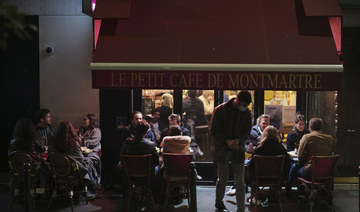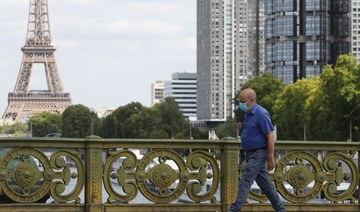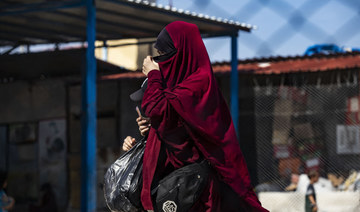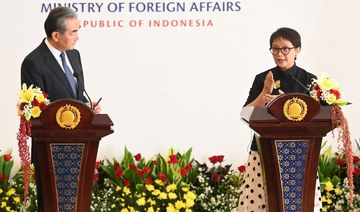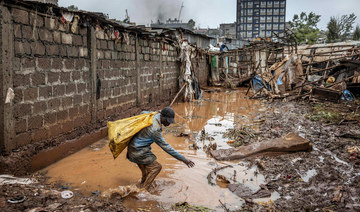PARIS: In the COVID-19 intensive care unit of the Antony Private Hospital south of Paris, no bed stays free for long and medics wonder when their workload will finally peak.
As one recovered elderly patient is being wheeled out of the ward, smiling weakly, boss Jean-Pierre Deyme is on the phone arranging the next arrival and calling out instructions to staff.
Louisa Pinto, a nurse of nearly 20 years’ experience, gestures to the vacated room where a cleaner is already at work, scrubbing down the mattress for the next arrival.
“The bed won’t even have time to cool down,” she says as the patient monitoring system beeps constantly in the background.
For now, everything is stable in the 20-odd beds around her where COVID-19 victims lie inanimate, in a silent battle with the virus.
Paris is going through a third wave of the pandemic which risks putting even more strain on saturated hospitals than the first wave in March and April last year.
“With what’s coming in April, it’s going to be very complicated,” says Pinto, a mother of three who hasn’t had a holiday since last summer and like other staff will be canceling a planned break this month.
Even with a new round of restrictions coming into force this week, Health Minister Olivier Veran predicts that infections in France will peak only in mid-April, while hospital admissions will continue climbing until the end of the month.
Alarming forecasts leaked to the French media from the Paris public hospital authority AP-HP last week showed anywhere from 2,800-4,400 people in intensive care in the Paris region by the end of April even with a strict lockdown.
In the first wave, the number peaked at 2,700.
The director of the Antony hospital, Denis Chandesris, says intensive care capacity has already been increased by drastically reducing all surgery except for critical cancer, cardiological and emergency cases.
Hospitals everywhere in the region have taken similar measures, re-deploying beds and creating new wards, but they are reaching their limits.
“The difficulty is not so much beds or material, it’s a question of finding medical and paramedical staff to be able to take in patients,” Chandesris explained.
Last Sunday, a group of emergency care directors in Paris warned in an open letter that the situation was so bad that medics would soon have to start “triage” – selecting patients for care based on their chances of survival.
This prospect horrifies staff – and President Emmanuel Macron has always promised to shield hospitals and avoid the sort of scenes witnessed in Italy last March when patients piled up in corridors.
In a televised speech to the nation on Wednesday night, he promised to increase intensive care capacity nation-wide from 7,665 beds currently to 10,000 – a jump of 30 percent.
“I want to thank medical students, retired people, the army health service and medical reserve volunteers. All of them will be mobilized in a larger way,” he announced.
Opposition politicians and some experts reacted with skepticism while an Ifop poll for the Journal du Dimanche weekly found only 35 percent of French people had confidence in their government “to deal effectively with the coronavirus.”
Pinto, the nurse, underlined how working in intensive care is “very technical,” requiring specialized training and knowledge.
Macron is banking on a limited lockdown over the next month turning the rising tide of cases which have roughly doubled to 40,000 a day compared with their level a month ago.
The sharp acceleration is down to the spread of the more contagious so-called British variant which has become dominant in France.
New measures include nation-wide travel restrictions, which limit people to 10 kilometers (six miles) from their homes, and the closure of schools and non-essential shops.
Only a significant increase in the vaccination campaign – which started sluggishly but is now picking up pace – fills any of the medics at Antony Private Hospital with any hope.
After months of lacking doses, the government is promising a major rollout this month and an increase in the rate of jabbing.
Samir Taik, a taxi driver from Paris, walked out of the Antony hospital last week as the 1,000th COVID-19 patient to have benefited from oxygen therapy in the COVID-19 intensive care unit.
The 43-year-old, who enjoys boxing and sport, is still short of breath and reeling from the trauma of seeing his health deteriorate so fast.
He says he knows three or four people with a similar profile to him who have been hospitalized recently.
“Young people need to know that we’re not talking about 80-year-olds, it’s people who are 30, 40, 45-year-olds and have no health problems. The British variant is not like the old one,” he said.
Paris medics fear worst of COVID-19 wave still to come
https://arab.news/v9seb
Paris medics fear worst of COVID-19 wave still to come
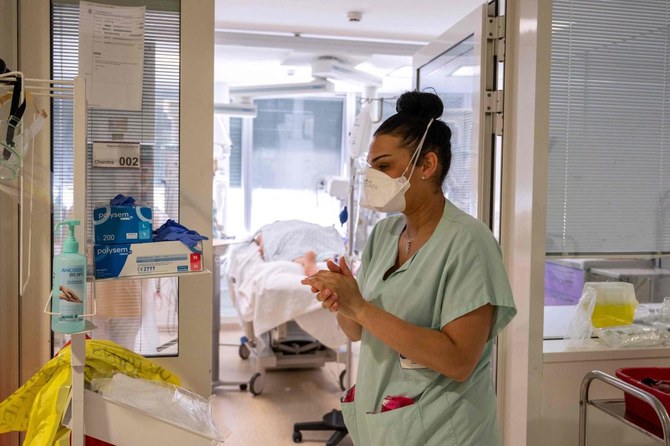
- Paris is going through a third wave of the pandemic which risks putting even more strain on saturated hospitals
- The sharp acceleration is down to the spread of the more contagious so-called British variant
Pet dogs and strays suffer in Asia heatwave

- Increasing number of animals suffer nosebleeds, severe skin rashes in Kolkata in heatwave
- Experts say climate change makes heatwaves more frequent, longer and more intense
Kolkata: Soaring temperatures across Kolkata have brought life in much of the Indian megacity to a standstill, but veterinarian Partha Das cannot recall a time when he was more busy.
His clinic has been swamped by distressed members of the public carrying in beloved pets suffering nosebleeds, severe skin rashes and lapses into unconsciousness in a relentless heatwave suffocating much of South and Southeastern Asia over the past week.
“Many pets are also hospitalized for three or four consecutive days, and they are taking a long time to get back to normal,” the 57-year-old told AFP from his surgery.
“We are getting several heatstroke cases in a day. It’s unprecedented.”
Kolkata has sweltered through days of punishing heat, peaking at 43 degrees Celsius for the hottest single April day since 1954, according to the city’s weather bureau.
Streets of the normally bustling colonial-era capital have been almost deserted in the afternoons as its 15 million people do what they can to stay out of the sun.
But even cats and dogs lucky enough to have an owner have been susceptible to falling ill, with Das saying the heat had triggered a surge in dehydration-related illnesses in pets from around the city.
Teacher Sriparna Bose said her two cats had become sullen and withdrawn in a way she hadn’t seen before when the heatwave hit.
“They are refusing food,” she said. “They hide in dark, cold corners of the room and won’t come out.”
The situation is worse for the 70,000 stray dogs estimated to live on city streets by municipal authorities, which have no owner but are often fed and tended to by nearby residents.
Many are spending the day taking refuge from the sun under parked cars, while a lucky few are hosed down by sympathetic humans to help them cool off.
“They are finding it difficult to stand on their soft paws because the roads are so hot,” said Gurshaan Kohli of Humanimal Foundation, a local animal welfare charity for stray animals.
“Scores of dogs and cats have died” even though he and his colleagues had rushed them to clinics for treatment, he added.
Large swathes of South and Southeast Asia are struggling through a heatwave that has broken temperature records and forced millions of children to stay home as schools close across the region.
Experts say climate change makes heatwaves more frequent, longer and more intense, while the El Nino phenomenon is also driving this year’s exceptionally warm weather.
The heat has taken its toll on animals across the continent.
“They are eating less, and they are reluctant to move,” Henna Pekko of Rescue PAWS, which operates an animal shelter near Thailand’s capital Bangkok, told AFP.
With temperatures in Thailand exceeding 40 degrees Celsius over the past week, Pekko said her charity had taken to bringing its rescues to the ocean to cool down with a swim, while older dogs were being kept indoors.
“We are definitely taking extra precautions because of this weather,” she told AFP, adding that the stress on animals from the heat was the worst she had experienced in the kingdom.
“Last year was bad. This year was worse.”
Minnesota man who regrets joining Daesh group faces sentencing on terrorism charge

- Federal prosecutors have recommended 12 years for Abelhamid Al-Madioum in recognition both of the seriousness of his crime and the help has he given the US
- Al-Madioum was 18 in 2014 when Daesh recruited him
MINNEAPOLIS, USA: A Minnesota man who once fought for the Daesh group in Syria but now expresses remorse for joining a “death cult” and has been cooperating with federal authorities will learn Wednesday how much prison time he faces.
Federal prosecutors have recommended 12 years for Abelhamid Al-Madioum in recognition both of the seriousness of his crime and the help has he given the US and other governments. His attorney says seven years is enough and that Al-Madioum, 27, stopped believing in the group’s extremist ideology years ago.
Al-Madioum was 18 in 2014 when Daesh recruited him. The college student slipped away from his family on a visit to their native Morocco in 2015. Making his way to Syria, he became a soldier for Daesh, until he was maimed in an explosion in Iraq. Unable to fight, he used his computer skills to serve the group. He surrendered to US-backed rebels in 2019 and was imprisoned under harsh conditions.
Al-Madioum returned to the US in 2020 and pleaded guilty in 2021 to providing material support to a designated terrorist organization. According to court filings, he has been cooperating with US authorities and allied governments. The defense says he hopes to work in future counterterrorism and deradicalization efforts.
“The person who left was young, ignorant, and misguided,” Al-Madioum said in a letter to US District Judge Ann Montgomery, who will sentence him.
“I’ve been changed by life experience: by the treachery I endured as a member of Daesh, by becoming a father of four, a husband, an amputee, a prisoner of war, a malnourished supplicant, by seeing the pain and anguish and gnashing of teeth that terrorism causes, the humiliation, the tears, the shame,” he added. “I joined a death cult, and it was the biggest mistake of my life.”
Prosecutors acknowledge that Al-Madioum has provided useful assistance to US authorities in several national security investigations and prosecutions, that he accepted responsibility for his crime and pleaded guilty promptly on his return to the US But they say they factored his cooperation into their recommended sentence of 12 years instead of the statutory maximum of 20 years.
“The defendant did much more than harbor extremist beliefs,” prosecutors wrote in a sentencing memo. “He chose violent action by taking up arms for Daesh.”
A naturalized US citizen, Al-Madioum was among several Minnesotans suspected of leaving the US to join the Daesh group, along with thousands of fighters from other countries worldwide. Roughly three dozen people are known to have left Minnesota to join militant groups in Somalia or Syria. In 2016, nine Minnesota men were sentenced on federal charges of conspiring to join Daesh.
But Al-Madioum is one of the relatively few Americans who’ve been brought back to the US who actually fought for the group. According to a defense sentencing memo, he’s one of 11 adults as of 2023 to be formally repatriated to the US from the conflict in Syria and Iraq to face charges for terrorist-related crimes and alleged affiliations with Daesh. Others received sentences ranging from four years to life plus 70 years.
Al-Madioum grew up in the Minneapolis suburb of St. Louis Park in a loving and nonreligious family, the defense memo said. He joined Daesh because he wanted to help Muslims who he believed were being slaughtered by Syrian President Bashar Assad’s regime in that country’s civil war. Daesh recruiters persuaded him “to test his faith and become a real Muslim.”
But he was a fighter for less than two months before he lost his right arm below the elbow in the explosion that also left him with two badly broken legs and other severe injuries. He may still require amputation of one leg, the defense says.
While recuperating in 2016, he met his first wife Fatima, an Daesh widow who already had a son and bore him another in 2017. They lived in poverty and under constant airstrikes. He was unable to work, and his stipend from Daesh stopped in 2018. They lived in a makeshift tent, the defense says.
He married his second wife, Fozia, in 2018. She also was a Daesh widow and already had a 4-year-old daughter. They had separated by early 2019. He heard later she and their daughter together had died. The first wife also is dead, having been shot in front of Al-Madioum by either rebel forces or an Daesh fighter in 2019, the defense says.
The day after that shooting, he walked with his sons and surrendered to the Kurdish-led Syrian Democratic Forces, which held him under conditions the defense described as “heinous” for 18 months until the FBI returned him to the US
As for Al-Madioum’s children, the defense memo said they were eventually found in a Syrian orphanage and his parents will be their foster parents when they arrive in the US.
Polish officials condemn arson attack on Warsaw synagogue

- Foreign Minister Radoslaw Sikorski, quoting the country’s chief rabbi, said “someone tried to set fire to the Nozyk synagogue with a Molotov cocktail“
- A statement from the Jewish community in Warsaw expressed its “concern and indignation” at the attack
WARSAW: Polish authorities on Wednesday condemned an arson attack against a Warsaw synagogue.
Foreign Minister Radoslaw Sikorski, quoting the country’s chief rabbi, said “someone tried to set fire to the Nozyk synagogue with a Molotov cocktail.”
“Thank God no-one was hurt,” the minister added in a post on X, formerly Twitter.
“I condemn this shameful attack on the Nozyk synagogue in Warsaw,” Polish President Andrzej Duda wrote on X. “Anti-Semitism has no place in Poland. There is no place for hate in Poland.”
An AFP journalist at the scene saw a black stain across a window that appeared to have been caused by flames, but there was no major damage to the synagogue.
A statement from the Jewish community in Warsaw to AFP expressed its “concern and indignation” at the attack.
“Fortunately, the synagogue was empty at night and the material damage is minor,” it added.
The fire from the Molotov cocktail burned itself out outside the building, said the text, from Eliza Panek, vice president of the Jewish community in Warsaw.
“For the moment, we don’t know anything about the person or persons behind the attack, or their motives,” she added.
Warsaw police told AFP they “always take this kind of incident seriously” and the would do everything to ensure those responsible were punished.
So far, no one has claimed responsibility for the attack.
But Sikorski’s message speculated on who might have carried out the attack on the 20th anniversary of Poland’s membership of the European Union.
“Maybe the same ones who scrawled the Stars of David in Paris?” he said.
French prosecutors started an investigation after several dozen Jewish symbols were daubed on buildings in Paris in October as tensions increased amid Israel’s war against Hamas in Gaza.
France believes that Russian security services were behind the vandalism, an official French source said, but Russia has denied any involvement.
Saudi tourism launches first travel show in Indonesia

- Over 1.5 million Indonesians visited Saudi Arabia in 2023
- Saudi Tourism Authority exhibit in Jakarta runs until May 5
JAKARTA: The Saudi Tourism Authority launched on Wednesday its first show exhibition in Indonesia to introduce the Kingdom’s cultural and adventure destinations to visitors from the world’s largest Muslim-majority country.
The tourism sector has been booming under Vision 2030, as the Kingdom positions itself as a dynamic, diverse, year-round tourism destination and market that will contribute 10 percent to the gross domestic product by 2030.
Welcomed with dates and qahwa — traditional Arabic coffee — Indonesians flocked the STA exhibition inaugurated by Saudi Hajj and Umrah Minister Tawfiq Al-Rabiah and Alhasan Aldabbagh, STA president for Asia-Pacific markets, at the Kota Kasablanka Mall in South Jakarta.
“Saudi and Indonesia are good countries that have enjoyed social and economic ties for many, many years, and we have been receiving and welcoming many Indonesian travelers who are going for Umrah and Hajj,” Aldabbagh told reporters.
“We want to attract even more Indonesians, not just to do Umrah but to explore other places … Indonesia is a special market for us because of this strong relationship.”
More than 1.5 million Indonesians visited the Kingdom in 2023, but as most of them traveled for Umrah and focused on pilgrimage sites, Saudi authorities are hoping that they will begin to also explore the country’s rich history and heritage.
Aldabbagh was expecting about 10,000 visitors daily at the Jakarta exhibition, which will run until May 5.
“We want people to learn about all the attractions that we have in Saudi … to come with their families and enjoy and discover,” he said, giving as examples Jeddah and AlUla.

A historical city on the eastern shore of the Red Sea, Jeddah from the 7th century has been a major port for Indian Ocean trade routes and also the gateway for Muslim pilgrims to Makkah.
Featured on the UNESCO World Heritage List, Jeddah has a distinctive architectural tradition, with influences from along the ancient trade routes.
AlUla, another UNESCO site, is an ancient desert oasis and one of the most significant cultural cradles in the Arabian Peninsula.
The ancient kingdoms flourished in the AlUla Valley between 800 and 100 B.C. and were followed by Hegra — Saudi Arabia’s first location registered on the World Heritage List — was a major city of the Nabataean civilization whose capital, Petra, was located in present-day Jordan.
The Saudi travel show in Jakarta has already drawn interest from prospective visitors, who said they are intrigued by the variety of destinations the Kingdom had to offer.
“This is good for us to gain more information because we’ve never had this before, this is rare. Usually, we’ll get information from travel agencies, but this is coming straight from the Saudi authorities,” said Yudi Prasetyo, a Jakarta resident.
Another visitor, Linda Wardani, was curious to explore the Kingdom’s ancient sites, which she has so far known only from social media channels.
“We are curious to see AlUla looking so wonderful,” she said. “We are even more curious about other destinations in Saudi Arabia because when it comes to Umrah, the destinations are commonly known, but aside from that, we’re seeing the growth of Saudi Arabia and there are other tourist sites to see.”
Halid Umar Bakadam, CEO of Dream Tour travel agency, has also observed a growing interest beyond Umrah. His company now offers extended tours, where visitors can go and see other destinations in the Kingdom.
“They are welcoming more tourists,” he said. “For the new destinations, there are quite many people showing interest.”
Kenya flood toll rises to 179 as homes and roads are destroyed

- The death toll in Kenya exceeds that from flooding triggered by the El Nino weather phenomenon late last year
- Last year’s rains followed the worst drought in large parts of East Africa in decades
NAIROBI: Floods and landslides across Kenya have killed 179 people since March, with hundreds of thousands forced to leave their homes, the government said on Wednesday, as dozens more were killed in neighboring Tanzania and Burundi.
Torrential rain and floods have destroyed homes, roads, bridges and other infrastructure across the region. The death toll in Kenya exceeds that from flooding triggered by the El Nino weather phenomenon late last year.
Last year’s rains followed the worst drought in large parts of East Africa in decades.
In Kitengela, 33 km (20 miles) from Nairobi, Kenya Red Cross workers were helping to rescue residents whose homes were marooned by flood waters.
They were also trying to rescue tourists trapped at camps in Narok, 215 km from Nairobi, the Kenya Red Cross said on X.
Nairobi’s highways authority said it had closed a section of a highway leading to the city and at least three other roads across the country due to flooding and debris.
The disaster prompted Pope Francis to speak out in sympathy with Kenyans during a general audience on Wednesday at the Vatican.
“I ... wish to express to the people of Kenya my spiritual closeness at this time as severe flooding has tragically taken the lives of many of our brothers and sisters, injured others and caused widespread destruction,” he said.



